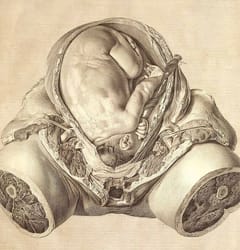

Anatomy of late pregnancy. Plate VI of The Anatomy of the Human Gravid Uterus, 1774
Jan Van Rymsdyk
Published in 1774, [William Hunter's] The Anatomy of the Human Gravid Uterus did much to advance the understanding of human pregnancy. The book contains 34 copper engravings. 31 of these magnificent medical illustrations were made by a mysterious man called Jan van Rymsdyk.
...For his book, Hunter was not interested in illustrations that showed an “ideal” uterus, but meticulous copies of real dissected specimens. In Hunter’s own words an illustration like this “represents what was actually seen, it carries the mark truth, and becomes almost as infallible as the object itself”. And this is exactly what Van Rymsdyk produced. William’s brother and famous surgeon John Hunter worked together with Van Rymsdyk in the dissecting room. John preparing the display from the corpse of women who had died in various stages of pregnancy, and Jan making life-size drawings in red chalk. These sketches were later made into engravings for the printing of the book.
...The sketches are almost photorealistic reproductions down to the tiniest wrinkle and hair. Other painters of the time criticized Van Rymsdyk for being too accurate and detailed. They saw his anatomical illustrations as a lower form of painting, as it was “just” copying and not the result of an artistic mind. In Museum Britannicum Van Rymsdyk defends his style of work. Here is a passage where he describes why he thinks it’s important to cover every tiny little detail. It could almost pass as a description of macro photography:
"there are three different ways of imitating an Object; the first is to dispose Nature at a tolerable Distance, suppose that of Fifteen Feet, where all the minutiae is lost... but the third is, where the Different Substances, and every minute Part is discovered by being brought so near the Eye. This Distance I was obliged to make use of, for to represent Nature in its greatest Beauty; the other two distances are what I would call only representing the Effect of Nature, as she appears at the Distance; or the Distance for an Artist to get a good deal of Money, and use much Art, but shew [show] little of Nature."
Ironically, it seems that Van Rymsdyk ended up feeling bitter about the only works he are known for today. In the conclusion to his Museum Britannicum book he writes that he has taken “a dislike to those Anatomical Studies etc. in which I was employed.” He also felt he had been ill-treated by William Hunter, who he accused of having discouraged him from becoming a “real” painter. Although he insistingly defended his style of art, it almost seems like he secretly did feel inferior to the “proper” artists.
William Hunter didn’t mention Van Rymsdyk in the Anatomy of the Human Gravid Uterus. The preface just refers to “the ingenious artists who made the drawings and engravings”. Maybe Hunter saw the dissection as the real art? Or the engravings that made it possible to print a book? Maybe it’s not so hard to understand he felt he had “Sacrificed his Talents”, as he put it.
Whatever he felt, Jan van Rymsdyk will always stand as one of the greatest medical illustrators of all time. And although he drew and painted, in a way it feels like he was the first medical photographer, documenting the specific rather than the general. He certainly didn’t sacrifice his talents, but put them to use for a greater good – the advancement of medicine. (https://sterileeye.com/2010/03/19/jan-van-rymsdyk-drawer-of-wombs/)
Uploaded on by Suzan Hamer
Jan Van Rymsdyk
artistArthur
Wait what?